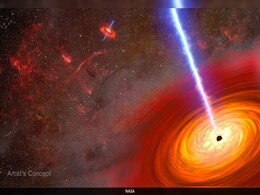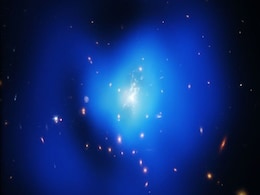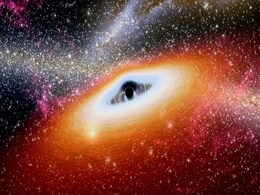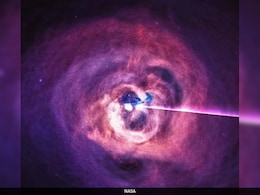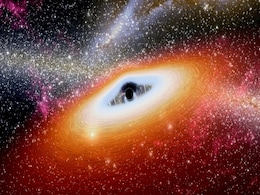Supermassive Black Hole
- All
- News
-

When Two Massive Black Holes Merged And Went Flying Across Cosmos
- Sunday March 9, 2025
- Science | Edited by Anjali Thakur
The researchers propose that this ejection resulted from the collision of two galaxies, causing their central black holes to merge into a larger one.
-
 www.ndtv.com
www.ndtv.com
-

Supermassive Black Hole May Be Hiding in Large Magellanic Cloud, Scientists Suggest
- Monday March 10, 2025
- Written by Gadgets 360 Staff
A potential supermassive black hole may exist in the Large Magellanic Cloud, as per recent scientific findings. Researchers analysed hypervelocity stars moving at extreme speeds and found many could have been ejected from this neighbouring galaxy. The black hole is estimated to be around 600,000 times the mass of the Sun. If confirmed, this discove...
-
 www.gadgets360.com
www.gadgets360.com
-

Study Reveals Evidence of Supermassive Black Hole Inside Nearby Galaxy
- Friday March 7, 2025
- World News | Reuters
A study based on the trajectory of nine fast-moving stars observed at the fringes of the Milky Way provides strong evidence for the existence of a supermassive black hole inside the Large Magellanic Cloud.
-
 www.ndtv.com
www.ndtv.com
-

Astronomers Discover Largest Collection of Missing Link Black Holes in Dwarf Galaxies
- Thursday February 20, 2025
- Written by Gadgets 360 Staff
Astronomers have uncovered 2,500 dwarf galaxies containing active black holes using DESI data. This marks the largest-ever discovery of intermediate-mass black holes, with 300 new candidates identified. These findings could help scientists understand how black holes evolve from stellar-mass to supermassive sizes. The research, based on 410,000 gala...
-
 www.gadgets360.com
www.gadgets360.com
-

JWST Identifies Cooling Gas in Phoenix Cluster, Unlocking Star Formation Process
- Thursday February 20, 2025
- Written by Gadgets 360 Staff
The James Webb Space Telescope has detected the missing cooling gas in the Phoenix Cluster, a galaxy cluster located 5.8 billion light-years away. Researchers used the Mid-Infrared Instrument (MIRI) to identify gas at around 540,000 degrees Fahrenheit trapped in cavities within the cluster. This discovery resolves a long-standing mystery of how sta...
-
 www.gadgets360.com
www.gadgets360.com
-

James Webb Space Telescope Captures Sagittarius A Emitting Continuous Flares in Milky Way’s Core
- Thursday February 20, 2025
- Written by Gadgets 360 Staff
The James Webb Space Telescope has captured Sagittarius A*, the Milky Way’s supermassive black hole, emitting flares continuously. These bursts, varying in intensity and duration, have been observed over multiple sessions. Scientists believe the activity may be linked to magnetic interactions within the accretion disk. The phenomenon appears rand...
-
 www.gadgets360.com
www.gadgets360.com
-

Webb Telescope Unveils Hidden Process Behind Star Formation in Phoenix Cluster
- Friday February 14, 2025
- Written by Gadgets 360 Staff
NASA’s James Webb Space Telescope has uncovered the missing link in star formation within the Phoenix galaxy cluster. By mapping intermediate-temperature gas, researchers identified a crucial phase of cooling that was previously undetected. This discovery explains why the cluster’s supermassive black hole does not fully prevent star formation, ...
-
 www.gadgets360.com
www.gadgets360.com
-

Astronomers Find a 200,000-Light-Year Black Hole Jet in the Early Universe
- Monday February 10, 2025
- Written by Gadgets 360 Staff
Astronomers have identified the longest black hole jet observed in the early universe, stretching 200,000 light-years—twice the Milky Way’s width. Found in quasar J1601+3102, this jet was detected using the LOFAR telescope. Despite the black hole being 450 million times the Sun’s mass, it isn’t among the most massive. Scientists believe env...
-
 www.gadgets360.com
www.gadgets360.com
-

JWST Detects Unexpectedly Massive Black Holes in the Early Universe
- Monday February 3, 2025
- Written by Gadgets 360 Staff
A new study led by Jorryt Matthee of ISTA reveals that black holes in early galaxies were significantly more massive than expected. Using JWST data, researchers found that some black holes accounted for nearly 10% of their galaxy's stellar mass—far exceeding the 0.01% ratio seen in modern galaxies. The findings challenge existing growth models, s...
-
 www.gadgets360.com
www.gadgets360.com
-

Astronomers Discover 19 New Quasars Using DESI Legacy Surveys Data
- Wednesday January 29, 2025
- Written by Gadgets 360 Staff
Using data from the DESI Legacy Surveys photometry catalog, 19 new quasars were identified, including strongly-lensed, dual, and projected types. Observations were carried out on October 15–16, 2023, at California's Palomar Observatory using the P200/DBSP instrument. Among the findings are two lensed quasars, J0746+1344 and J2121-0826, which exhi...
-
 www.gadgets360.com
www.gadgets360.com
-

Hear The Universe Roar: NASA Reveals Haunting Audio From A Supermassive Black Hole
- Tuesday January 28, 2025
- Science | Edited by Nikhil Pandey
NASA has released an eerie audio clip of sound waves emanating from a supermassive black hole in the Perseus galaxy cluster, 250 million light-years away.
-
 www.ndtv.com
www.ndtv.com
-

Astronomers Capture Supermassive Black Hole Plasma Jets at Birth
- Tuesday January 28, 2025
- Written by Gadgets 360 Staff
For the first time, plasma jets from a supermassive black hole have been observed in real time. Located 270 million light-years away in galaxy 1ES 1927+654, the jets traveled at one-third the speed of light. Emerging in 2024 after a radio flare in 2023, the jets broke through dense gas near the black hole, which has a mass 1.4 billion times that of...
-
 www.gadgets360.com
www.gadgets360.com
-

M87 Black Hole: Turbulent Plasma Dynamics and Feeding Process Revealed
- Tuesday January 28, 2025
- Written by Gadgets 360 Staff
M87*, the supermassive black hole in Messier 87, continues to captivate astronomers. EHT observations from 2017 and 2018 revealed turbulence in the accretion flow, with the plasma ring’s brightest region shifting due to gas dynamics. The study also uncovered a counter-rotating gas spiral feeding mechanism, refining understanding of black hole fee...
-
 www.gadgets360.com
www.gadgets360.com
-

Astronomers Spot Hundreds of Hidden Supermassive Black Holes Using Infrared
- Tuesday January 21, 2025
- Written by Gadgets 360 Staff
Hundreds of hidden supermassive black holes have been identified using infrared observations, offering fresh insights into their role in galaxy formation. Researchers relied on data from NASA's Infrared Astronomical Satellite (IRAS) and the Nuclear Spectroscopic Telescope Array (NuSTAR) to detect emissions from black holes obscured by thick clouds ...
-
 www.gadgets360.com
www.gadgets360.com
-

Astronomers Observe Black Hole Reactivate, Emitting Jets of Plasma
- Monday January 20, 2025
- Written by Gadgets 360 Staff
A supermassive black hole at the center of galaxy 1ES 1927+654 has been observed reactivating after a quiet period. Jets of hot gas were released from both sides of the black hole, surprising astronomers. Researchers speculate that a white dwarf star in close orbit may be interacting with the black hole, providing key insights into cosmic behavior....
-
 www.gadgets360.com
www.gadgets360.com
-

When Two Massive Black Holes Merged And Went Flying Across Cosmos
- Sunday March 9, 2025
- Science | Edited by Anjali Thakur
The researchers propose that this ejection resulted from the collision of two galaxies, causing their central black holes to merge into a larger one.
-
 www.ndtv.com
www.ndtv.com
-

Supermassive Black Hole May Be Hiding in Large Magellanic Cloud, Scientists Suggest
- Monday March 10, 2025
- Written by Gadgets 360 Staff
A potential supermassive black hole may exist in the Large Magellanic Cloud, as per recent scientific findings. Researchers analysed hypervelocity stars moving at extreme speeds and found many could have been ejected from this neighbouring galaxy. The black hole is estimated to be around 600,000 times the mass of the Sun. If confirmed, this discove...
-
 www.gadgets360.com
www.gadgets360.com
-

Study Reveals Evidence of Supermassive Black Hole Inside Nearby Galaxy
- Friday March 7, 2025
- World News | Reuters
A study based on the trajectory of nine fast-moving stars observed at the fringes of the Milky Way provides strong evidence for the existence of a supermassive black hole inside the Large Magellanic Cloud.
-
 www.ndtv.com
www.ndtv.com
-

Astronomers Discover Largest Collection of Missing Link Black Holes in Dwarf Galaxies
- Thursday February 20, 2025
- Written by Gadgets 360 Staff
Astronomers have uncovered 2,500 dwarf galaxies containing active black holes using DESI data. This marks the largest-ever discovery of intermediate-mass black holes, with 300 new candidates identified. These findings could help scientists understand how black holes evolve from stellar-mass to supermassive sizes. The research, based on 410,000 gala...
-
 www.gadgets360.com
www.gadgets360.com
-

JWST Identifies Cooling Gas in Phoenix Cluster, Unlocking Star Formation Process
- Thursday February 20, 2025
- Written by Gadgets 360 Staff
The James Webb Space Telescope has detected the missing cooling gas in the Phoenix Cluster, a galaxy cluster located 5.8 billion light-years away. Researchers used the Mid-Infrared Instrument (MIRI) to identify gas at around 540,000 degrees Fahrenheit trapped in cavities within the cluster. This discovery resolves a long-standing mystery of how sta...
-
 www.gadgets360.com
www.gadgets360.com
-

James Webb Space Telescope Captures Sagittarius A Emitting Continuous Flares in Milky Way’s Core
- Thursday February 20, 2025
- Written by Gadgets 360 Staff
The James Webb Space Telescope has captured Sagittarius A*, the Milky Way’s supermassive black hole, emitting flares continuously. These bursts, varying in intensity and duration, have been observed over multiple sessions. Scientists believe the activity may be linked to magnetic interactions within the accretion disk. The phenomenon appears rand...
-
 www.gadgets360.com
www.gadgets360.com
-

Webb Telescope Unveils Hidden Process Behind Star Formation in Phoenix Cluster
- Friday February 14, 2025
- Written by Gadgets 360 Staff
NASA’s James Webb Space Telescope has uncovered the missing link in star formation within the Phoenix galaxy cluster. By mapping intermediate-temperature gas, researchers identified a crucial phase of cooling that was previously undetected. This discovery explains why the cluster’s supermassive black hole does not fully prevent star formation, ...
-
 www.gadgets360.com
www.gadgets360.com
-

Astronomers Find a 200,000-Light-Year Black Hole Jet in the Early Universe
- Monday February 10, 2025
- Written by Gadgets 360 Staff
Astronomers have identified the longest black hole jet observed in the early universe, stretching 200,000 light-years—twice the Milky Way’s width. Found in quasar J1601+3102, this jet was detected using the LOFAR telescope. Despite the black hole being 450 million times the Sun’s mass, it isn’t among the most massive. Scientists believe env...
-
 www.gadgets360.com
www.gadgets360.com
-

JWST Detects Unexpectedly Massive Black Holes in the Early Universe
- Monday February 3, 2025
- Written by Gadgets 360 Staff
A new study led by Jorryt Matthee of ISTA reveals that black holes in early galaxies were significantly more massive than expected. Using JWST data, researchers found that some black holes accounted for nearly 10% of their galaxy's stellar mass—far exceeding the 0.01% ratio seen in modern galaxies. The findings challenge existing growth models, s...
-
 www.gadgets360.com
www.gadgets360.com
-

Astronomers Discover 19 New Quasars Using DESI Legacy Surveys Data
- Wednesday January 29, 2025
- Written by Gadgets 360 Staff
Using data from the DESI Legacy Surveys photometry catalog, 19 new quasars were identified, including strongly-lensed, dual, and projected types. Observations were carried out on October 15–16, 2023, at California's Palomar Observatory using the P200/DBSP instrument. Among the findings are two lensed quasars, J0746+1344 and J2121-0826, which exhi...
-
 www.gadgets360.com
www.gadgets360.com
-

Hear The Universe Roar: NASA Reveals Haunting Audio From A Supermassive Black Hole
- Tuesday January 28, 2025
- Science | Edited by Nikhil Pandey
NASA has released an eerie audio clip of sound waves emanating from a supermassive black hole in the Perseus galaxy cluster, 250 million light-years away.
-
 www.ndtv.com
www.ndtv.com
-

Astronomers Capture Supermassive Black Hole Plasma Jets at Birth
- Tuesday January 28, 2025
- Written by Gadgets 360 Staff
For the first time, plasma jets from a supermassive black hole have been observed in real time. Located 270 million light-years away in galaxy 1ES 1927+654, the jets traveled at one-third the speed of light. Emerging in 2024 after a radio flare in 2023, the jets broke through dense gas near the black hole, which has a mass 1.4 billion times that of...
-
 www.gadgets360.com
www.gadgets360.com
-

M87 Black Hole: Turbulent Plasma Dynamics and Feeding Process Revealed
- Tuesday January 28, 2025
- Written by Gadgets 360 Staff
M87*, the supermassive black hole in Messier 87, continues to captivate astronomers. EHT observations from 2017 and 2018 revealed turbulence in the accretion flow, with the plasma ring’s brightest region shifting due to gas dynamics. The study also uncovered a counter-rotating gas spiral feeding mechanism, refining understanding of black hole fee...
-
 www.gadgets360.com
www.gadgets360.com
-

Astronomers Spot Hundreds of Hidden Supermassive Black Holes Using Infrared
- Tuesday January 21, 2025
- Written by Gadgets 360 Staff
Hundreds of hidden supermassive black holes have been identified using infrared observations, offering fresh insights into their role in galaxy formation. Researchers relied on data from NASA's Infrared Astronomical Satellite (IRAS) and the Nuclear Spectroscopic Telescope Array (NuSTAR) to detect emissions from black holes obscured by thick clouds ...
-
 www.gadgets360.com
www.gadgets360.com
-

Astronomers Observe Black Hole Reactivate, Emitting Jets of Plasma
- Monday January 20, 2025
- Written by Gadgets 360 Staff
A supermassive black hole at the center of galaxy 1ES 1927+654 has been observed reactivating after a quiet period. Jets of hot gas were released from both sides of the black hole, surprising astronomers. Researchers speculate that a white dwarf star in close orbit may be interacting with the black hole, providing key insights into cosmic behavior....
-
 www.gadgets360.com
www.gadgets360.com

